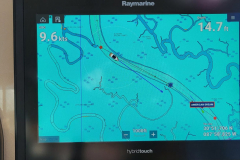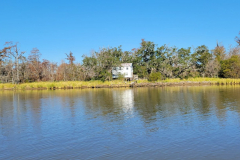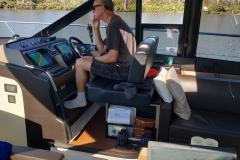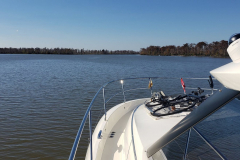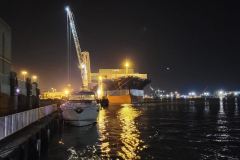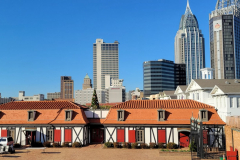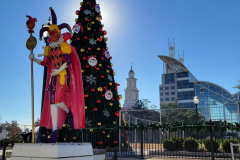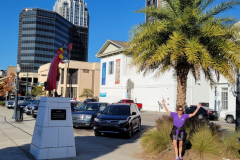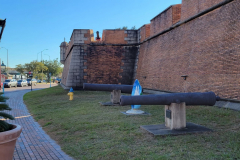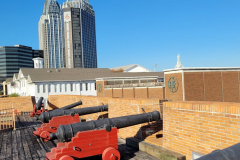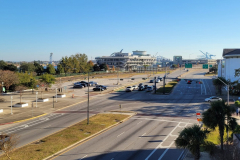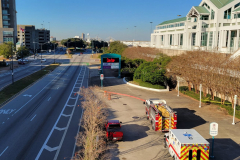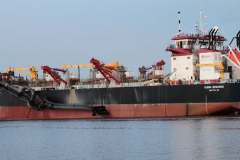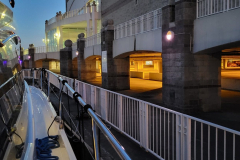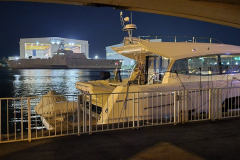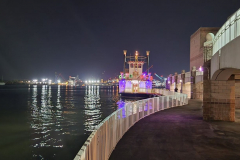Up early this morning to a heavy fog surrounding us that was so thick you couldn’t see the shoreline. We had company last night as Highlander III joined us in this spectacular anchorage. We couldn’t see her even though she was at our stern about 500 ft away. So we kicked back, had an extra tea and waited until the sun would show her face to evaporate the cloud around us. It would turn out to be another hour. Not too bad because we are on the last of the journey on the rivers for only 40 miles. No more locks to the Gulf of Mexico. We will be staying at a city dock at Mobile Convention Center in downtown Mobile. There are no facilities here for the boater. However, you can explore the city and watch the 24/7 marine and shipping industry do its thing.
The final run down the Mobile River was much easier than yesterday. Still passing at least 6 tows and barges, yet again, but the water isn’t as narrow and as twisty as yesterday. Buoys are still not available but with room to spare it is an easy pass of tugs. The shoreline has no more bluffs, no more hills. It gives way to sandy, bog here in the Delta. The Delta refers to the runoff areas of wetlands, bog, marsh or whatever you wish to call it that alligators like. No we did not see any today. We did see the short palm trees though which brought a big smile to our faces along with the 72F temps that we will have to cruise with. Our pods are throwing a fault code and we lost our depth finder. Boat work in exotic places yet again.
Entering the Mobile River near Mobile we see a lot more barges off to the side waiting for their tow to pick them up and bring them north. It becomes more industrial as you leave the sounds of nature behind you and hear the hum of cranes, gantrys, ships, barges, tows, welding and men working. It changes rather quickly. We pass some ocean cargo ships waiting to be filled or emptied here in the Port of Mobile. There are war ships being manufactured here as well. We will see more of those tomorrow as we approach the mouth of Mobile Bay where there is more being built and serviced.
The Convention Center dock is a wharf with permanent rubber fenders available. We place ours between them and the boat for added protection. No power or water. Lots of construction and manufacturing noise but it is good to stay for one night before heading out into the Bay. It is the only way to see the city from downtown unless you head down the Bay to Dog River and rent a car.
We head into the city for a walk on Dauphin St. The old style, early 1900’s buildings rest along the Main Street of Old. It is mainly bars and restaurants now with a few legal offices. We found a park where some folks were feeding the squirrels. The squirrels by the hundreds. Where are they supposed to go but in a park full of oak trees dropping their acorns. Folks feed them peanuts with the shells directly from their hands. We continue wandering around find a few more parks, but no squirrels. Eventually we happen upon a replica of the old Fort Conde. Again wandering through the old fort and reading about how the French, Spanish, British and the Indigenous people worked and created war to determine the current status of the United States. It is very different reading about US history from an American perspective.
The fort guarded Mobile and its citizens for almost 100 years, from 1723-1820. The fort had been built by the French to defend against British or Spanish attack on the strategic location of Mobile and its Bay as a port to the Gulf of Mexico, on the easternmost part of the French Louisiana colony. The strategic importance of Mobile and its fort was significant: the fort protected access into the strategic region between the Mississippi River and the Atlantic colonies along the Alabama and Tombigbee Rivers. A crew of 20 black slaves and 5 white workmen performed original work on the fort. During 1763 to 1780, Britain was in possession of the region, and the fort was renamed in honor of Queen Charlotte. From 1780 to 1813, Spain ruled the region, and the fort was renamed Fuerte Carlota. In 1813, Mobile was occupied by United States troops, and the fort was renamed again as Fort Charlotte. It stands now as a small replica of its origins along the waterfront of the Mobile River. I was today’s year old when I found out that Mardi Gras began in Mobile, AL and not New Orleans. Every year there is a Mardi Gras here on the streets of Mobile to celebrate.
